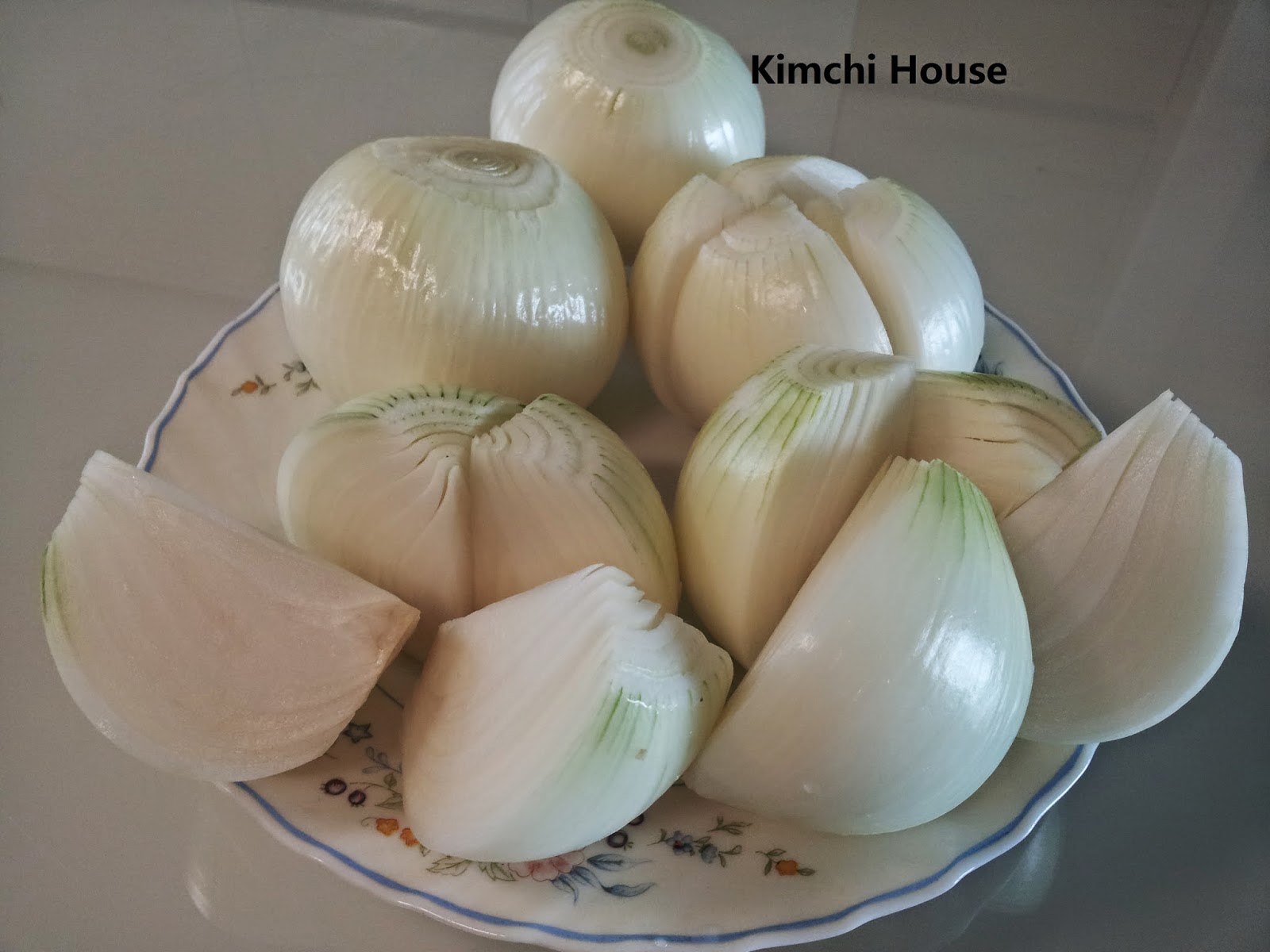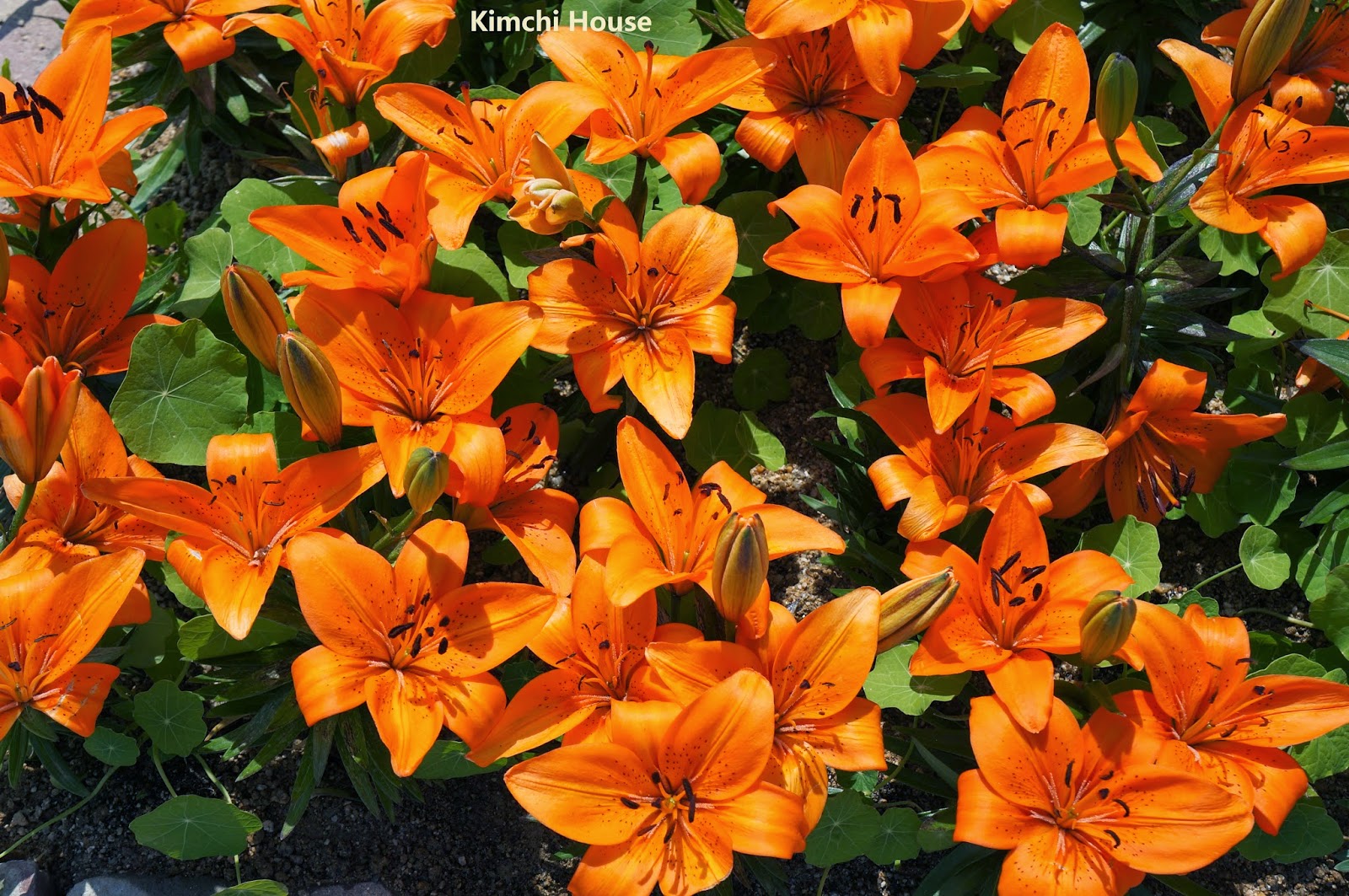"Yang-Pa Kimchi" Onion Kimchi /洋葱泡菜/양파김치
2014/04/29 11:59
|
亲爱的朋友们,若您喜欢吃洋葱,不妨试试这道洋葱泡菜!
The onion (Allium cepa) (Latin 'cepa' = onion), also known as the bulb onion or common onion.Onions are cultivated and used around the world. As a foodstuff they are usually served cooked, as a vegetable or part of a prepared savoury dish, but can also be eaten raw or used to make pickles or chutneys. They are pungent when chopped and contain certain chemical substances which irritate the eyes. Onions contain phenolics and flavonoids that have potential anti-inflammatory, anti-cholesterol, anticancer and antioxidant properties.
Common onions are normally available in three colour varieties. Yellow or brown onions (called red in some European countries), are full-flavoured and are the onions of choice for everyday use. Yellow onions turn a rich, dark brown when caramelized and give French onion soup its sweet flavour. The red onion (called purple in some European countries) is a good choice for fresh use when its colour livens up the dish. It is also used in grilling and char-broiling. White onions are the traditional onions that are used in classic Mexican cuisine. They have a golden colour when cooked and a particularly sweet flavour when sautéed.
Onions are often chopped and used as an ingredient in various hearty warm dishes, and may also be used as a main ingredient in their own right, for example in French onion soup or onion chutney. They are very versatile and can be baked, boiled, braised, grilled, fried, roasted, sautéed or eaten raw in salads. Their layered nature makes them easy to hollow out once cooked, facilitating stuffing them. Onions are a staple in Indian cuisine, often used as a thickening agent for curries and gravies. Onions pickled in vinegar are eaten as a snack. These are often served as a side serving in pubs and fish and chip shops throughout the United Kingdom and The Commonwealth, often served with cheese and/or ale in the United Kingdom. In North America, sliced onions are battered and deep fried and served as onion rings.
洋蔥(学名:Allium cepa),古時稱做興蕖、現在北京人称葱头、甘肅人稱洋蒜、新疆人稱皮牙孜(源自维语Piyaz)、是一種常見的蔥科蔥屬植物。
洋蔥的主要食用部位是鱗葉,主要作調味用。洋蔥含有大蒜素,有很強烈的刺激味道。切洋蔥時,這種味道會刺激人的眼睛和鼻子,使之流淚。虽然生的时候味道辛辣,但是烹饪之后不会太刺激。洋蔥原產於中亞,现有很多不同的品種,已经用于世界各地的食物。洋蔥有淨化血液的功效,其中的二烯丙基二硫是刺鼻氣味的主要成分,能夠預防血液凝固、有效清血,並降低血液中的膽固醇。
洋蔥也在生物實驗課或生物課本中出现,因為洋蔥的取得方便,並且不具有葉綠體,常拿來和一般植物的葉細胞當做比較。
五葷(蔥、蒜、韭、薤、興蕖)和三厭(所有動物)之一。
( source : Wikipedia )
Cut each of the onion into 4 portions...
用刀划开洋葱,分成4等份。。。
Chop the chives for about 1 cm long, slice the garlic and ginger for long thin stripes..
将韭菜切成约 1 cm的长度,蒜头和姜则切成细条状。。。
Mix the glutinous rice paste with red pepper powder,anchovy sauce,salt,sugar,pear juice..
将糯米胡与辣椒粉,江鱼子露,盐,糖,梨汁拌均。。
Rinse onions and drain well, remove the water with the kitchen tower..
用水洗掉盐份,沥干水份,用纸巾抹干水份。。。
Rub the spicy stuffing between the onions...
将内馅塗在每一片的洋葱片上。。Ingredients :
5 big onions
chives 220 g
garlic 50 g
ginger 30 g
salt 2 1/2 Tsp
Kimchi stuffing :
glutinous rice powder 3 Tsp
water 2/3 cup
red pepper powder 6 Tsp
anchovy sauce 1 1/2 Tsp
sugar 1 1/2 tsp
salt 1 Tsp
fresh Korean pear juice 2 Tsp (optional )
Method :
1. Peel the outer layer of the onions. Cut each of the onion into 4 portions, sprinkle salt in between the onion, Set aside for about 20-25 minutes.
2. Chop the chives for about 1 cm long ; slice the garlic and ginger for long thin stripes.
3. Mix the glutinous rice paste ( mix the glutinous rice powder and water, boil it, to make paste) with the red pepper powder,anchovy sauce,sugar ,salt and pear juice. Stir it well.
4. Rinse the salted onions and drain well, remove the water from the onions by using the kitchen tower.
5. Rub the spicy stuffing between the onion.
6. Put the stuffed onions in the container and storage it in the refrigerator for about 7 days pr more before you taste it.
材料:
5 粒大洋葱
韭菜 220 g
蒜头 50 g
姜 30 g
盐 2 1/2 Tsp
内馅:
糯米粉 3 Tsp
水 2/3 杯
辣椒粉 6 Tsp
韩式江鱼子露 1 1/2 Tsp
糖 1 1/2 tsp
盐 1 Tsp
鲜梨汁 2 Tsp ( 可免)
做法 :
1. 除去洋葱外皮,用刀划开成 4 等份。在洋葱片之间,均匀地撒上盐,静置 20-25
分钟。
2. 将韭菜切成约 1 cm的长度,蒜头和姜则切成细条状。。。
3. 将糯米胡(糯米粉加入水,煮成糊状)和辣椒粉,江鱼子露,盐,糖和鲜梨汁拌均。
4. 用水轻轻地清洗洋葱,洗掉盐份,沥干水份 (用纸巾抹干水份)。
5. 将拌均的内馅料,塗在每一片的洋葱片上。
6. 放入保鲜盒。放在冰箱发酵约 7 天后 或以上才享用。












































